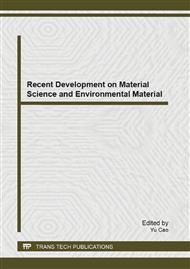[1]
S. P. Yan, M. X. Fang, J. L. Wang, Z. Y. Luo, K. F. Cen, An analysis of regeneration energy consumption in absorption and dissociation processes of flue gas CO2 and its simulation. Journal of Power Engineering, 27 (2007) 969-974.
Google Scholar
[2]
H. Chen, B. Dou, Y. Song, Y. Xu, X. Wang, Y. Zhang, X. Du, C. Wang, X. Zhang, C. Tan, Studies on absorption and regeneration for CO2 capture by aqueous ammonia. International Journal of Greenhouse Gas Control, 6 (2012) 171-178.
DOI: 10.1016/j.ijggc.2011.11.017
Google Scholar
[3]
S. Ma, H. Song, M. Wang, J. Yang, B. Zang, Research on mechanism of ammonia escaping and control in the process of CO2 capture using ammonia solution. Chem. Eng. Res. Des. (2013).
DOI: 10.1016/j.cherd.2013.01.020
Google Scholar
[4]
H. Kheshgi, H. Coninck, J. Kessels, Carbon dioxide capture and storage: Seven years after the IPCC special report. Mitigation and Adaptation Strategies for Global Change, 17 (2012) 563-567.
DOI: 10.1007/s11027-012-9391-5
Google Scholar
[5]
J. Zhang, Z. Li, C. Li, J. Zhang, Z. Jim, .X. Li, Z. Zhang, G. Cheng, Dual benefits of a new CO2 sequestration technology from fossil fuel power plants. Modern Electric Power, 29 (2002) 1-7.
Google Scholar
[6]
A. C. Yeh, H. Bai, Comparison of ammonia and monoethanolamine solvents to reduce CO2 greenhouse gas emission. Sci. Total Environ. 228 (1999) 121-133.
DOI: 10.1016/s0048-9697(99)00025-x
Google Scholar
[7]
Y. J. Kim, J. K. You, W. H. Hong, K. B. Yi, C. H. Ko, J. N. Kim, Characteristics of CO2 absorption into aqueous ammonia. Sep. Sci. Technol. 43 (2008) 766-777.
Google Scholar
[8]
J. K. You, H. S. Park, S. H. Yang, W. H. Hong, W. Shin, J. K. Kang, K. B. Yi, and J. N. Kim, Influence of additives including amine and hydroxyl groups on aqueous ammonia absorbent for CO2 capture. J. Phys. Chem. B, 112 (2008) 4323-4328.
DOI: 10.1021/jp711113q
Google Scholar
[9]
J. T. Yeh, K. P. Resnik, K. Rygle, H. W. Pennline, Semi-batch absorption and regeneration studies for CO2 capture by aqueous ammonia. Fuel Process. Technol. 86 (2005) 1533-1546.
DOI: 10.1016/j.fuproc.2005.01.015
Google Scholar
[10]
A. Corti, L. Lombardi. Reduction of carbon dioxide emissions from a SCGT/CC by ammonia solution absorption-preliminary results. Int. J. Thermodynamics. 7 (2004) 173-181.
Google Scholar


